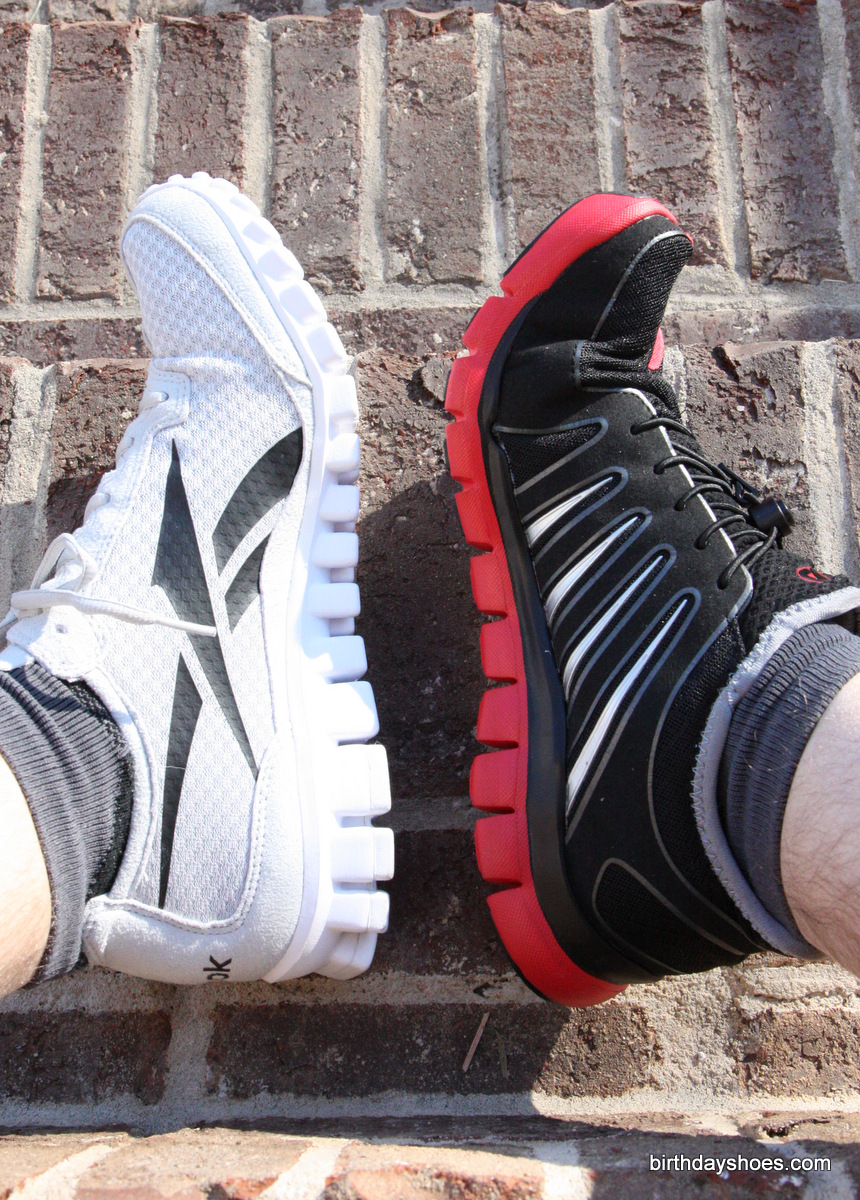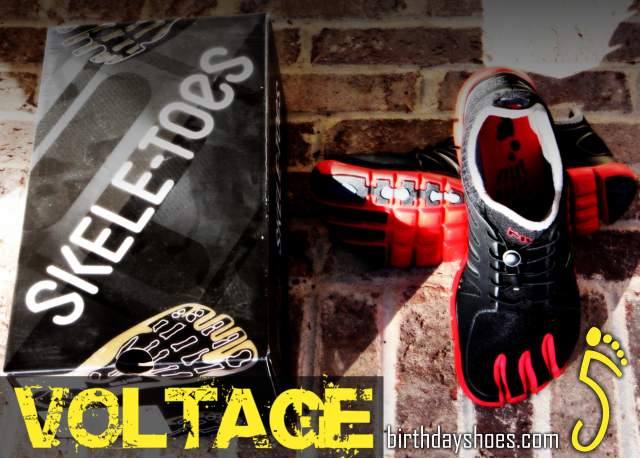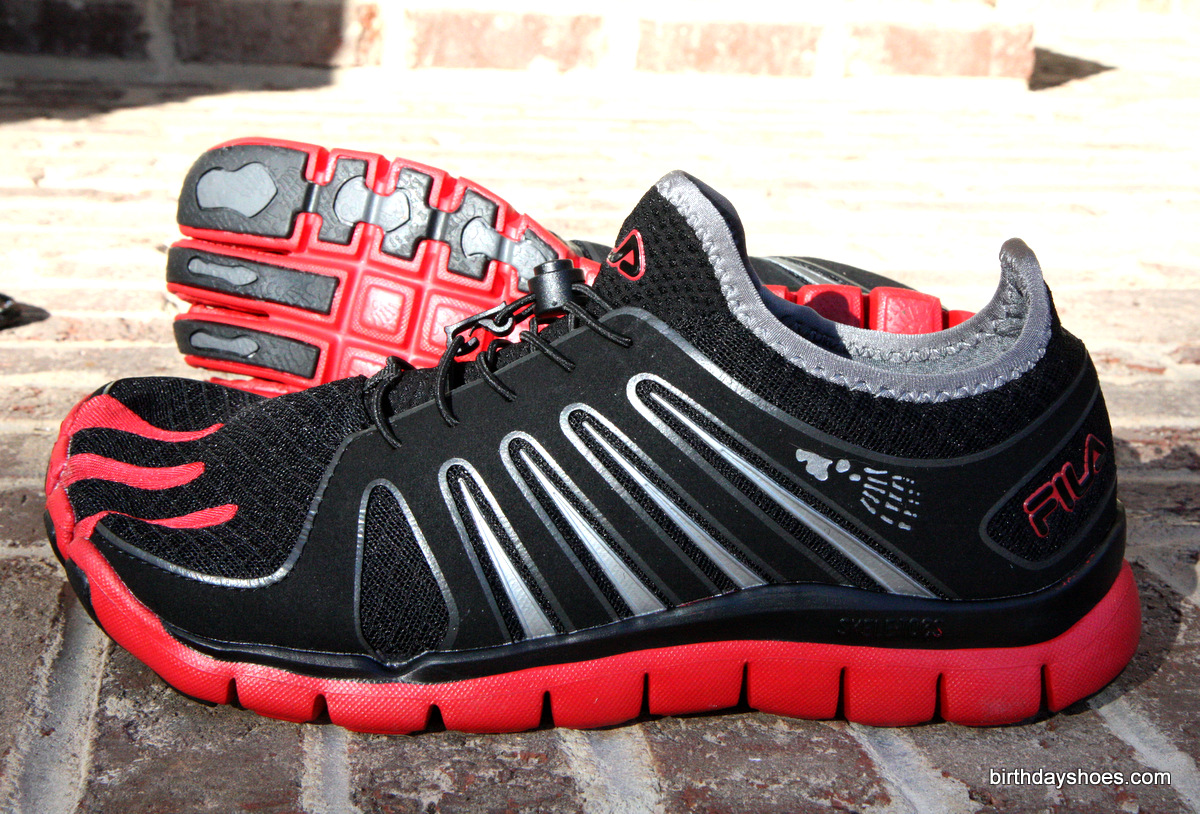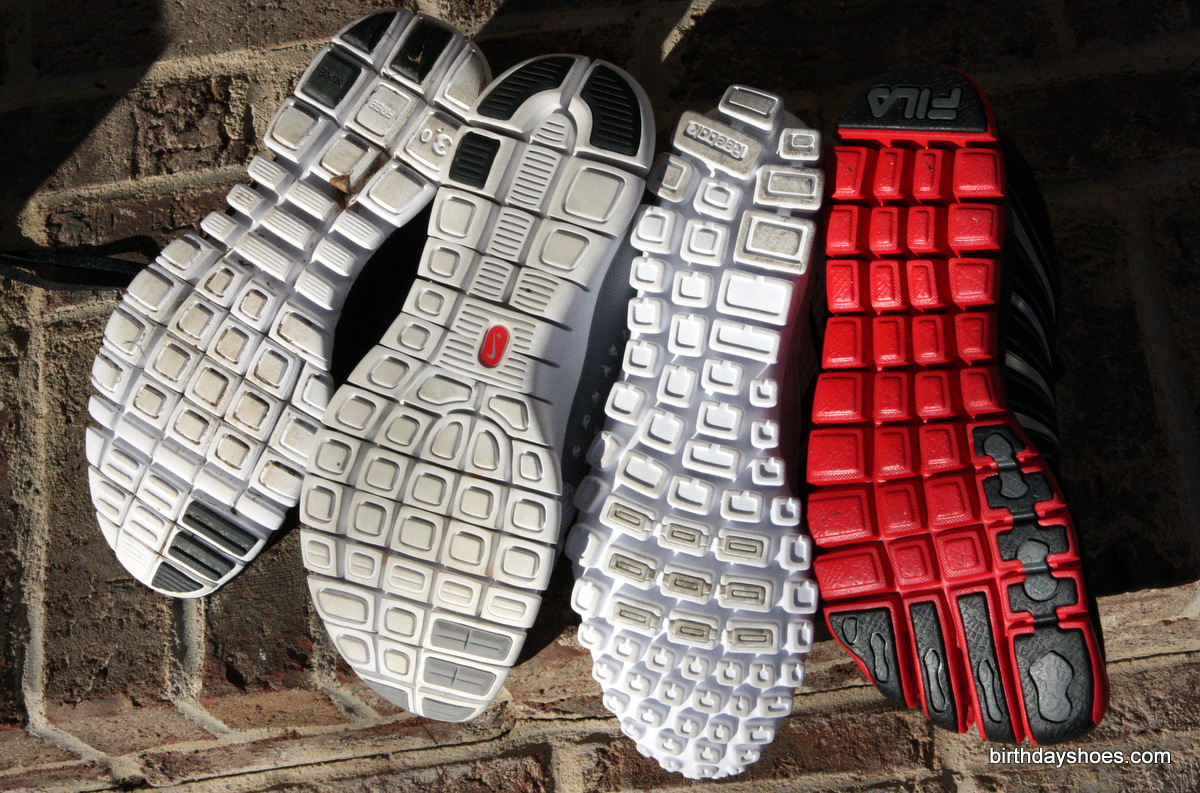What if the grid-foam-soled shoe, as pioneered by Nike via the “Nike Free x.0,” somehow copulated with a pair of toe shoes?
God forbit it but what would you get? Well, you don’t have to think too hard because Fila has done just that. Allow me to introduce The Skele-Toes Voltage: a four-toed Frankenstein toe-shoe-slash-sneaker-slash-Nike-Free-wannabee. Take that in for a minute. Are you horrified? All your worst nightmares in shoe design made reality? While it’s easy to gasp at the site of these monstrosities — the “marshmallow shoes” we all know as Nike Frees turned into toe shoes — is this yet one more example of Skele-toes “innovating” by mashing together winning concepts from other brands? We’ve certainly seen plenty of Nike-Free-wannabes — Reebok RealFlex being the most popular, but also Skechers GoRun — I’m sure there are others, too. And we all know Fila is being sued by Vibram over intellectual property rights involving toe shoes (See our original Skele-toes review here; the Skele-toes 2.0 review here). Is the Skele-toes Voltage just something to be derided by minimalist footwear and toe shoes fans, alike, for being nothing more than a thick, cushion-y ugly mess? Nope. It’s actually got some redeemable qualities — nay, it may actually be even better than the Nike Free! Read on for a bit of history on the Nike Free marshmallow “barefoot” shoe, grid-soled shoe functionality, and how the Skele-toes Voltage stacks up and actually beats the competition, in many ways. You could call this a case study on marshmallow shoes and toe shoes. Read on after the jump!A precursor: What of the “barefoot” Nike Free
It’s impossible to talk about the Skele-toes Voltage without first talking about the Nike Free. Basically, the Nike Free line universally (I think) features a cut-up, foamy grid-sole design. It’s as though you took a thick sheet of foam and diced it up into little cubes. The function from this form is that you get a more flexible, dynamic sole — with a lot of cushioning. That plush ride plus the resulting look of the white Nike Free soles leave them looking like you glued a bunch of marshmallows to the bottom of your shoe. That’s why Nike Frees are often called “marshmallow shoes.” Seriously though, the grid-cut, thick foam sole really is an improvement, I think, over the alternative; it really does increase the flexibility of the sole to have lateral and vertical cuts; indeed, it’s one of the reasons toe shoes are more flexible at the front versus regular shoes; more movable parts means a mo dynamic shoe. Long-time readers may know that I’ve yet to review the Nike Frees on BirthdayShoes.com. This is despite the fact that a) there is a huge fan-base of the Nike Free line: people really like their marshamllow shoes! Match that up to b) the fact that Nike markets the Free as being close to barefoot. It’s common knowledge among minimalist footwear enthusiasts that Nike Frees were born out of Nike having studied barefoot running. The Nike Frees were Nike’s first “barefoot shoe.” To wit, Chris McDougall wrote about the birth of the Nike Free in Born to Run. You can read that excerpt below if you’re interested in the history behind the Free (it’s fascinating to me):Bowerman had died by the time the barefoot uprising was taking hold in 2002, so Nike went back to Bowerman’s old mentor to see if this shoeless stuff really had merit. “Of course!” Arthur Lydiard reportedly snorted. “You support an area, it gets weaker. Use it extensively, it gets stronger. . . . Run barefoot and you don’t have all those troubles.” “Shoes that let your foot function like you’re barefoot—they’re the shoes for me,” Lydiard concluded. Nike followed up that blast with its own hard data. Jeff Pisciotta, the senior researcher at Nike Sports Research Lab, assembled twenty runners on a grassy field and filmed them running barefoot. When he zoomed in, he was startled by what he found: instead of each foot clomping down as it would in a shoe, it behaved like an animal with a mind of its own—stretching, grasping, seeking the ground with splayed toes, gliding in for a landing like a lake-bound swan. “It’s beautiful to watch,” a still spellbound Pisciotta later told me. “That made us start thinking that when you put a shoe on, it starts to take over some of the control.” He immediately deployed his team to gather film of every existing barefoot culture they could find. “We found pockets of people all over the globe who are still running barefoot, and what you find is that during propulsion and landing, they have far more range of motion in the foot and engage more of the toe. Their feet flex, spread, splay, and grip the surface, meaning you have less pronation and more distribution of pressure.” Faced with the almost inescapable conclusion that it had been selling lemons, Nike shifted into make-lemonade mode. Jeff Pisciotta became head of a top-secret and seemingly impossible project: finding a way to make a buck off a naked foot. It took two years of work before Pisciotta was ready to unveil his masterpiece. It was presented to the world in TV ads that showed so many barefoot athletes—Kenyan marathoners padding along a dirt trail, swimmers curling theier toes around a starting block, gymnasts and Brazilian capoeira dancers and rock climbers and wrestlers and karate masters and beach soccer players—that after a while, it was hard to remember who does wear shoes, or why. Flashing over the images were motivational messages: “Your feet are your foundation. Wake them up! Make them strong! Connect with the ground. . . . Natural technology allows natural motion. . . . Power to your feet.” Across the sole of a bare foot is scrawled “Performance Starts Here.” Then comes the grand finale: as “Tiptoe Through the Tulips” crescendos in the background, we cut back to those Kenyans, whose bare feet are now sporting some kind of thin little shoe. It’s the new Nike Free, a swooshed slipper even thinner than the old Cortez. And it’s slogan? “Run Barefoot.”Millions of people have now bought the Nike Free in some shape or form. You’ll note that the Frees come in varying thicknesses at the soles, which result in their names like the Nike Free 5.0 (photoed above) or the Nike Free 3.0 (these are the two versions I have). The irony of the Nike Free, which is so well known (and bemoaned) by barefoot- or minimalist-running enthusiasts is just how far the Nike Frees are from being barefoot. There is hardly anything “barefoot” about the Frees, even in their most minimally soled iterations. Oh the gnashing of teeth these shoes have caused us! The truth is that Nike Frees have been popular for very good reasons: the cut-up foam sole does do a great deal to decrease the block-like, brick shoe feel of more plush sneakers. People like shoes that don’t utterly rob their feet of their natural function. People like footwear that is comfortable. Like it or lump it, the Nike Frees are comfortable shoes to many, many people. It’s the success of Nike’s Free line that has spawned a slew of copy-cat designs or riffs on the “marshmallow shoe” concept (some of which are noted above). Thus it was only a matter of time before Fila jumped on the bandwagon; they just decided to go the distance and articulate the toes.
Meet the Skele-toes Voltage
Given the Nike Free and a pair of four-toed Skeletoes (this is a pic), it’s incredibly easy to imagine what a toed Nike Free would look like; well, with the Voltage, all the guesswork has been eliminated. Just take a look at the Skele-toes Voltage and you’ll have to agree — it really is theHow do they work?
If you’ve worn a pair of the Nike Frees, the Voltage doesn’t feel all that different. It’s a plush ride with a notable heel-to-toe differential. The rear thickness of the sole is about 25mm vs. what looks like half that at the forefoot or about 12.5mm (as measured using skinfold calipers; I’ll do some comparisons to other shoes below). 12.5 mm allows for a surprising amount of ground feel at the front of the Voltage; of course, your biomechanics are going to be degraded dramatically by the elevated heel (which is the ultimate downfall of this design). Thanks to the foot-shaped design of the Voltage last, they’re both easy to put on and don’t cramp my toes. The upper of the Voltage is “tongue-less”, too, utilizing a speed-lacing system (like Vibram’s Bikila LS, though the idea didn’t originate with Vibram, it’s still kinda funny). In short, they’re pretty comfortable. Meanwhile, the articulation of the toes actually works to make these shoes more dynamic. This is how they set themselves apart from the Frees and Free-wannabes, after all, but in the case of the Skele-toes Voltage, articulating the toes isn’t just a gimmick to catch the eye; separate toes on a marshmallow shoe make for a more dynamic shoe. And really, that’s sorta interesting, don’t you think? It makes sense and it’s one of the reasons toe shoes work in the first place: adhering the sole to your foot across the toes makes the shoe move more in concert with your foot. It’s really that simple.Aesthetics

I actually like the look of these but the blasted heel lift just takes the completely off the table.
Concluding thoughts
I haven’t spent a lot of time in these shoes. I’ve not run in them. I’ve not walked miles in them. So this “review” can’t go in-depth about their pros and cons. Why? Well, despite my surprised delight in finding toe articulation could make the marshmallow shoe more functional, the elevated heel and major heel-to-toe drop immediately kills my interest in the Skele-toes Voltage. If messes with my natural biomechanics by encouraging me to strike at the heel too soon (my foot catches the ground too early in my stride). Meanwhile, my posture is negatively impacted as my heel elevation changes my balance. Knowing these issues, why would I subject myself to wearing them regularly? I love this site but not gonna do it! There may be a place for transitional footwear as people rehabilitate their feet from years of walking and running in “high-heeled” sneakers and try to move to a more minimally soled, natural and biomechanically neutral shoe (should such a shoe exist); however, over a centimeter in drop as with the Voltage is probably too much. That said, perhaps you could do worse …Skele-toes Voltage vs. Nike Free 5.0, 3.0 and Reebok RealFlex
(How’s that for a segue?) In the event you’re angling for a pair of marshmallow shoes, well, you’ve got some options. I’m going to keep my comparisons of the Skele-toes Voltage to the Nike Free Run+, Nike Free 3.0, and Reebok Realflex, as I have these shoes (and maybe will review them one day — any interest?). Skele-toes Voltage vs. Nike Free Run+ 5.0 The Nike Free Run+ or 5.0 measures about 27mm thick at the heel and about 18mm at the forefoot. The foam rubber sole of the Free Run 5.0 is markedly, incredibly more rigid than the Voltage. It’s also more narrow at the forefoot than the Voltage. The Nike Free Run+ is also not nearly as comfortable worn with bare feet despite using a similar, sock-style upper; it’s too narrow in the forefoot. The Voltage does have a more prominent arch to it, but overall it’s no comparison way more comfortable to wear. Better ground feel and more dynamic flexibility in the toes, which have plenty of room to wiggle. Aesthetically, I like the Frees better. Winner: Skele-toes Voltage.
Skele-toes Voltage vs. Nike Free Run 3.0
The Nike Free Run+ or 5.0 measures about 27mm thick at the heel and about 18mm at the forefoot. The foam rubber sole of the Free Run 5.0 is markedly, incredibly more rigid than the Voltage. It’s also more narrow at the forefoot than the Voltage. The Nike Free Run+ is also not nearly as comfortable worn with bare feet despite using a similar, sock-style upper; it’s too narrow in the forefoot. The Voltage does have a more prominent arch to it, but overall it’s no comparison way more comfortable to wear. Better ground feel and more dynamic flexibility in the toes, which have plenty of room to wiggle. Aesthetically, I like the Frees better. Winner: Skele-toes Voltage.
Skele-toes Voltage vs. Nike Free Run 3.0
 The Nike Free 3.0 is more flexible bending the shoe vertically than the Skele-toes Voltage but unbelievably stiff to bend laterally (the 5.0 is similarly hard to bend laterally across the forefoot). The Free 3.0s are measuring about 24mm thick at the heel and around 18mm thick at the forefoot, which is the same forefoot measurement as the 5.0s. When I got the 3.0s they were the most minimally thick-soled of the Frees available, but this was a couple years back, so not sure if that is still the case or not. Like their heftier cousins, the 3.0s also aren’t a pleasure to wear on my barefoot and there’s a lot of pressure from the upper against the top of my feet in them. Biomechanically, the 3.0s are definitely better due to a lesser heel-to-toe drop than the Skele-toes. Meanwhile, the Voltage has a roomier toed toe box than the narrow 3.0s. The 3.0s feel better through the arch. Winner: Voltage, barely.
Skele-toes Voltage vs. Reebok Realflex
The Nike Free 3.0 is more flexible bending the shoe vertically than the Skele-toes Voltage but unbelievably stiff to bend laterally (the 5.0 is similarly hard to bend laterally across the forefoot). The Free 3.0s are measuring about 24mm thick at the heel and around 18mm thick at the forefoot, which is the same forefoot measurement as the 5.0s. When I got the 3.0s they were the most minimally thick-soled of the Frees available, but this was a couple years back, so not sure if that is still the case or not. Like their heftier cousins, the 3.0s also aren’t a pleasure to wear on my barefoot and there’s a lot of pressure from the upper against the top of my feet in them. Biomechanically, the 3.0s are definitely better due to a lesser heel-to-toe drop than the Skele-toes. Meanwhile, the Voltage has a roomier toed toe box than the narrow 3.0s. The 3.0s feel better through the arch. Winner: Voltage, barely.
Skele-toes Voltage vs. Reebok Realflex
 I was surprised to find that I really like the Reebok RealFlex upper. It’s pretty comfortable on the sockless foot; yet the Voltage actually is more comfortable. However, style-wise I like the minimal styling of the RealFlex. The sole flexibility of the RealFlex is improved laterally over the Nike Frees, but not quite as good when compared bending from heel-to-toe; overall, the Skele-toes Voltage sole is more flexible. The RealFlex foam rubber is a bit stiffer than the Voltage, too. I could see that being a pro or a con depending on how you look at it. The main drawbacks of the RealFlex are it’s narrow last cramping the toes and it’s fairly thick sole; I’m measuring it at about 33mm thick at the heel and 26mm at the forefoot. The RealFlex simply puts your foot very high off the ground compared to all the other marshmallow shoes listed here; meanwhile, it also has the most narrow sole (see the lead sole comparison photo above); combine the toe and I find the RealFlex unstable — when I pronate just walking around it’s like my foot is suddenly on a lateral seesaw. The first time I tried them on I felt completely unstable. For me, wearing the RealFlex would lead to a rolled ankle in short order. They do have a less pronounced arch; I think they just need to chop off 10mm off their soles (at least). Winner: Skele-toes Voltage.
I’ll wrap the comparisons up with two more comments: one; you’d be better served picking up a pair of the original New Balance Minimus or the Merrell Bare Access (or the Altra Instincts!) over any of the above shoes because they’re all neutral from heel-to-toe while still providing some of that
I was surprised to find that I really like the Reebok RealFlex upper. It’s pretty comfortable on the sockless foot; yet the Voltage actually is more comfortable. However, style-wise I like the minimal styling of the RealFlex. The sole flexibility of the RealFlex is improved laterally over the Nike Frees, but not quite as good when compared bending from heel-to-toe; overall, the Skele-toes Voltage sole is more flexible. The RealFlex foam rubber is a bit stiffer than the Voltage, too. I could see that being a pro or a con depending on how you look at it. The main drawbacks of the RealFlex are it’s narrow last cramping the toes and it’s fairly thick sole; I’m measuring it at about 33mm thick at the heel and 26mm at the forefoot. The RealFlex simply puts your foot very high off the ground compared to all the other marshmallow shoes listed here; meanwhile, it also has the most narrow sole (see the lead sole comparison photo above); combine the toe and I find the RealFlex unstable — when I pronate just walking around it’s like my foot is suddenly on a lateral seesaw. The first time I tried them on I felt completely unstable. For me, wearing the RealFlex would lead to a rolled ankle in short order. They do have a less pronounced arch; I think they just need to chop off 10mm off their soles (at least). Winner: Skele-toes Voltage.
I’ll wrap the comparisons up with two more comments: one; you’d be better served picking up a pair of the original New Balance Minimus or the Merrell Bare Access (or the Altra Instincts!) over any of the above shoes because they’re all neutral from heel-to-toe while still providing some of that 



22 replies on “Fila Skele-toes Voltage: Nike Free,Toe Shoes Lovechild”
I would never run in them, but I do a lot of biking and the VFF aren’t so great for that. I can’t wear normal shoes since the toebox is too narrow. They look like they’d be perfect for biking! I would buy them for that.
I’m not sure I agree with the assessment of the toebox on the Frees. Compared to my Merrells and Altras the Frees have a stretchy fabric that lets my toes move all over. The flexibility of the sole is nice, too. The heel lift and the fact that the marshmallows grab all sorts of sticks and rocks in the grooves is not.
wait.. .where’s the USB connector for these? as a cool ad-on, fila could
have added some red LED lights
around the sole.
now, that’s a Real “VOLTAGE”!!!
I don’t consider these to be minimalist shoes. I would consider the Hoka OneOne to be more minimalist this these shoes. Why?
Personally, I find the heel drop is the most important factor for me. Any heal rise over 2-4mm I feel an extreme amount of pain when I wear them.
Here is my list of minimalist criteria:
1.) Zero Drop.
2.) Wide Toe Box or Individual Toe Pockets.
3.) Flexibility.
4.) Weight.
5.) Ground feel.
I tend to care about it in that order as well. If the shoe is not Zero Drop or extremely close to it… I can’t consider it minimalist. That is my main factor for differentiating “normal” shoes from minimalist shoes.
The Hoka OneOne has less of a heal rise then these Voltage. So even though the Hokas have less ground feel I would consider it more minimalist then the Voltage.
Personally, I would not even try these on. I know they would hurt my back after a short time wearing them. I would rather go with the Skeletoes 1.0 or 2.0 over the Voltage. Simply because of the zero drop. I wish they would have designed this the exact same way, but just made it level from heel to toe. Even though it had a stack height of 14mm, I will still be interested.
I have 5 toes, not 4 ergo Skeletoes aren’t for me.
VFFs have been successful in abetting my pinky’s revolution against the other toes.
In all seriousness though, Skeletoes have gotten better compared to their first ultra-stiff iteration. Cushioning isn’t a big deal but it’s OUTSOLE cushioning meaning it can’t be removed. Also, they aren’t zero drop. If you shaved off the heel so that it is 12.5mm stack throughout then maybe they have a contender. 12mm drop is way too much.
Heck, if you shaved off the entire outsole to about 10mm you’d have a half decent offering, although you’d need lugs on the outsole so that it isn’t slippery (foam on anything slick makes you fall).
@Robert,
Interesting comparison to the Hoka OneOne, but I’m not sure it makes sense to 1) even consider the Skele-toes Voltage as minimalist 2) consider the Hoka One One as minimalist — neither are minimalist in my opinion. The H11s are incredibly cushioned; how can a huge stack height be considered minimal? Are crocs minimalist-ish because they have a sizeable toe box and are lightweight?
And while this brings up a whole nother discussion, which is the spectrum of “how barefoot is such-and-such shoe?” I think to fall in the minimalist category, you have to sorta satisfy all the criteria to some extent and not completely whiff on one of them. I’d say the Voltage completely whiffs on the heel-to-toe differential; the H11s completely whiff on ground feel/cushioning.
@John,
I think a good analogy here is toe socks vs. regular socks. Regular socks are pretty stretchy, but they still tend to cramp your toes into a small space, even though your toes can push back and expand that space (if you want them to). Toe socks don’t have this problem. To me, that’s a big difference.
Really? Really, really?
@Justin
I think you are right. You can’t really call them minimalist. They still tend to get grouped with minimalist shoes unfortunately. Fila even uses the word minimal on the shoe packaging.
It really opens up a much broader discussion of what is a minimalist shoe. I think if you ask 10 poeple you will probably get 10 different answers.
Maybe there should be a minimal-ish category. Not really minimal but has some properties of minimalist shoes. The Voltage and Hoka would fall more in to a minimal-ish category. I can think of several more that would fit in to a minimal-ish shoes category.
I do think the Voltage would be a better option then the Niki Free line. I would consider these shoes to be an excellent option for someone who is afraid of the transition.
There’s a Skeletoes billboard near my house that says “Toe-tally original”. Yeah right…
Calling a tail a leg doesn’t make it one.
I’d like to see a review of the new Nike Free 3.0 (v4) these “look” really low. I think they have a 4mm drop. I really want to want a pair. 😉
Check out they way they’re marketing the 3.0 rolled into a ball.
http://www.nike.com/runningfeatures/static/features/
what’s next? HIGH-HEELS with toe pockets??
i think lady gaga will be more than willing to promote them….
imagine the morning after:
there’s minimalist shoes thrown all over
the place and gaga screams:
“noooo! these are not minimalist shoes!
no zero drop, huge sole, and man, they are wayyy too bulky!”
Ohgods I feel like a traitor. My mother bought me a pair because I have a pair of Vibrams and she saw them in my fav color. Although numerous things bug me like the arch support, two toes squished into one pocket, and the heel drop, it’s still better than my sneakers which I’ve been wearing when my aqua KSOs wouldn’t fit.
For some reason I thought the ride would be more “plush”. It didn’t feel as squishy as I thought.
And of course, when I mentioned the arch support and padding, she was proud of herself for finding such a good toe shoe. Lol!
I’ll keep them just to not break it to her. Besides a tag fell off. It’ll be a good replacement for my sneakers.
I have been walking, running and working out in fivefingers and zemgear for over 1 year now and dont have other shoes. I do a lot och parkour and non of the fivefingers and zemgear are good for that. I found the Fila voltage in my city and tried them on and it was a mixed feeling. But i think i will get a pair for just parkour. In parkour i need a little thicker sole.
But all the other time is always fivefinger 24/7
I bought a pair of these at the Finish Line at our local mall a couple of days ago. Yeah, they’re on sale.
I used to do a lot of distance running, but screwed up some disks in my back and neck, so I had to stop. One of my friends told me he’d tried this barefoot gig and he was able to return to running, which got my interest since I haven’t been able to get the intensity of exercise I need since I quit.
I tried the forefoot strike with a pair of NB trainers I have, and it was hard to do because they aren’t designed for that, so I grabbed these thinking that they’d do for a kind of transition to less obnoxiously heavy running shoes, and the lower impact forefoot strike.
Wore them last night just walking around, and they are VERY comfortable for that, at least, so I’ll be keeping them and trying out running and hiking later on this week. I think.
I’ve worn through five pairs of vibrams. I experimented by gluing old shoe soles to worn-out vibrams to give me some protection from rocks during night runs. I might try the four-toes shoes but would wait for cheap chinese knockoffs to become available before investing in brand names. I’m guessing four-toes would lead to blisters from #4 and #5 rubbing which is why I’d want to try knockoffs first.
kevin
–For starters I’m VERY green to the minimalist shoe movement–
I tried these on at a Dick’s Sporting Goods this past weekend, and I actually like them a lot. They felt pretty comfortable to walk around in and also seemed like they would breathe pretty well. I did notice, what I would call, a large bubble in the arch area, it threw me off a bit (mildly irritating) because it felt so prominent. I do plan to pick up a pair of Vibram KSOs in the very near future, but for my first toe-shoe purchase, I think these would be great for walking in 🙂
Voltage is my first pair of toe shoes, and I love them. I’d been wanting to try VFFs but there were 2 major factors against them:
1. Money. I didn’t want to spend a lot of cash on something I wasn’t sure I’d like.
2. My job requires me to go into some places, like mechanical rooms, where I would feel very uncomfortable with a thin sole. I don’t need steel-toed shoes for what I do but I do need something with a decent sole thickness in case I accidentally step on something.
The Voltage gives me the sole thickness I need while allowing me to try out this toe shoe thing. They’re the most comfortable shoes I own. I can walk for hours in them with no soreness and they’re the only shoes that don’t aggravate a minor foot injury that’s been annoying me for months now. I really like the aesthetics too.
I think they’re a great shoe for someone transitioning to a more minimalist shoe or for someone who needs a thicker sole for whatever reason. I can’t comment on running since I don’t, but I know they’re wonderful for walking.
Because of my good experience with these shoes, I’ll probably buy a more minimalist shoe for when I’m not at work. For work, I’ll keep wearing my Voltages whenever I’m not required to wear steel toes.
I like the streamlined look in the picture on the grass. But correct me if I am wrong…don’t most people have 5 toes? Is there an interior separation of the “ring” toe and the pinky toe?
I love mine..until you run more than 3miles on it..your big toe start sliding and too much arch support that it makes you supinate..I got mine from Kohls and it’s called the Fila Leap. my other shoes don’t make me supinate..only the fila leap. and I only ran with them for like 5-6 days total
I just love them shoe they are incredible
I ran 12km in them and for once no sore feet i have tried many different shoes on the market, And can honestly say that the skeletoes are amazing i bought 2 pairs, both the skeletoes amp and the voltage. All in all i would say that you should not diss them before trying them.
Anyone know what the difference between the amps and the voltage is? I can’t find it anywhere.